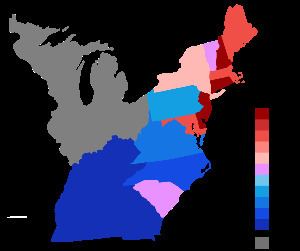August 12, 1796 - October 15, 1797 1798 → 57 49 Start date 1796 | 47 seats 59 seats 10 10 | |
 | ||
Winner Jonathan Dayton | ||
Elections to the United States House of Representatives for the 5th Congress took place in the various states took place between August 12, 1796 (in North Carolina), and October 15, 1797 (in Tennessee). The first session was convened on May 15, 1797, at the proclamation of the new President of the United States, John Adams. Since Kentucky and Tennessee had not yet voted, they were unrepresented until the second session.
Contents
- Election summaries
- Tennessee
- Connecticut
- Massachusetts
- New Hampshire
- North Carolina
- Pennsylvania
- Rhode Island
- South Carolina
- Vermont
- Virginia
- References
A number of gains for the Federalist Party provided the president with a reliable majority in support of his policies. Many of the Federalist pick-ups in Congress came from the former Middle Colonies (New York, Pennsylvania, New Jersey, and Delaware). New England remained heavily Federalist, whereas the South and West favored Democratic-Republican candidates. Federalist trade and infrastructure policies found widespread approval in the Mid-Atlantic states during this era. With the growth of cities in Maryland, Pennsylvania, and New York, government intervention in the interest of industrialization and mercantilism became more attractive to voting citizens in these areas.
During this period, each state fixed its own date for a congressional general election. Elections to a Congress took place both in the even-numbered year before and in the odd-numbered year when the Congress convened. In some states the congressional delegation was not elected until after the legal start of the Congress (on the 4th day of March in the odd-numbered year).
Election summaries
During this period, each state fixed its own date for a congressional general election. Elections took place both in the even-numbered year before and in the odd-numbered year when a Congress convened. In some states, the congressional delegation was not elected until after the legal start of the Congress (on the 4th day of March in the odd-numbered year). The 1st session of the 5th Congress ran May 15 – July 10, 1797, before the states of Kentucky and Tennessee had their elections, causing those states to be unrepresented in the 1st session.
Tennessee
Tennessee became a state in 1796 near the end of the 4th Congress. Elections for its first representative were held the same year.
Connecticut
Four vacancies occurred during the 5th Congress, two of which were before the Congress met when Zephariah Swift declined to serve in the 5th Congress and Uriah Tracy resigned after being elected to the Senate. These two vacancies were filled by John Allen and James Davenport. The third occurred when James Davenport (F) died on August 3, 1797, and was replaced by William Edmond (F). The fourth occurred when Joshua Coit (F) died on September 5, 1798, and was replaced by Jonathan Brace (F).
An unsuccessful motion was made to expel Roger Griswold after a fight with Matthew Lyon of Vermont.
Massachusetts
Massachusetts' electoral law required a majority for election, necessitating additional trials in three districts.
In the 11th district, Theophilus Bradbury (F) resigned July 24, 1797, which vacancy was filled in a special election by Bailey Bartlett (F)
New Hampshire
In 1796, New Hampshire had a single at-large district with 4 seats. Each voter cast 4 votes and a majority of voters (12.5% of votes) was required to be elected. Since only three candidates received a majority, a run-off was held between the candidates in fourth and fifth place to fill the remaining seat.
Jeremiah Smith (F) resigned July 26, 1797, and a special election was held to fill the resulting vacancy, which elected Peleg Sprague (F).
North Carolina
Nathan Bryan (DR) of the 10th district died June 4, 1798, and was replaced in a special election by Richard Dobbs Spaight (DR)
Pennsylvania
Three vacancies occurred during the 5th Congress. The first occurred when George Ege (F) of the 5th district resigned in October 1797, and was replaced by Joseph Hiester (DR). The second occurred when Samuel Sitgreaves (F) of the 4th district resigned upon being appointed Commissioner to Great Britain and was replaced by Robert Brown (DR). The third occurred in the 1st district when John Swanwick (DR) died on August 1, 1798, and was replaced by Robert Waln (F).
Rhode Island
Rhode Island had an at-large district with two seats, each of which were elected separately.
Benjamin Bourne (F) resigned before the end of the 4th Congress but after being re-elected, and a special election was held to fill the resulting vacancies in both the 4th and 5th Congresses, which was won by Elisha R. Potter (F). Potter himself subsequently resigned sometime after July 1797, and was replaced in a second special election by Thomas Tillinghast (F).
South Carolina
One vacancy occurred during the 5th Congress in the 1st district when William L. Smith (F) resigned on July 10, 1797, and was replaced in a special election by Thomas Pinckney (F).
Vermont
Due to Vermont's election law requiring a majority to secure a congressional seat, the 1st district required three ballots to choose a winner.
Daniel Buck in the 2nd district resigned before the start of Congress and was replaced by Lewis R. Morris (F)
Virginia
Morgan's election in the 1st district was unsuccessfully challenged by Rutherford.
One vacancy occurred during the 5th Congress on October 2, 1798, when William B. Giles (DR) of the 9th district resigned on the grounds of ill health and in protest against the Alien and Sedition Acts. He was replaced in a special election by Joseph Eggleston (DR).
